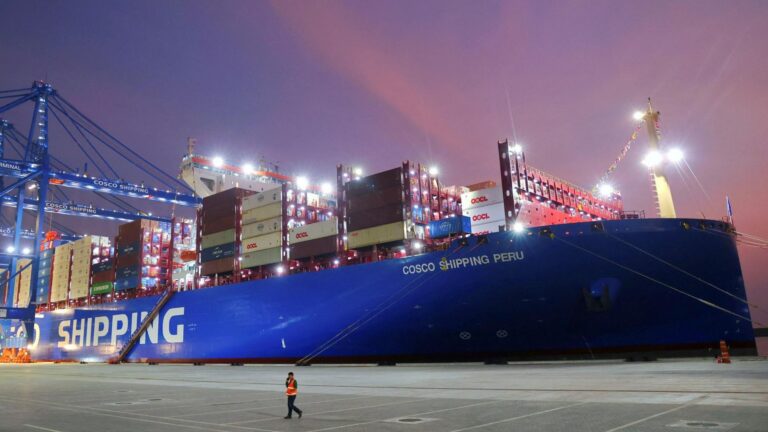A recent report from a prominent U.S. think-tank reveals that China has significantly expanded its influence over key ports throughout Latin America, raising strategic and economic concerns in Washington. According to findings highlighted by the Financial Times, Beijing’s growing presence in the region’s maritime infrastructure reflects a broader push to strengthen trade networks and geopolitical leverage in the Western Hemisphere. The report underscores the complex implications for Latin American nations balancing Chinese investment with traditional ties to the United States.
China’s Expanding Footprint in Latin American Ports Raises Strategic Concerns
Recent analyses reveal that China has secured operational stakes and influence in multiple key ports throughout Latin America, intensifying geopolitical tensions in the region. By leveraging a combination of infrastructure investments, long-term leasing agreements, and strategic partnerships, Beijing is enhancing its maritime reach while securing critical logistics hubs that are vital for global shipping routes. Notably, the operations under Chinese-linked entities span from container terminals in Brazil and Chile to crucial bulk cargo facilities in Panama and Argentina, marking a significant shift in control over regional trade arteries.
Strategic implications extend beyond commercial interests, prompting heightened alertness from Washington and allied capitals concerned about China’s expanding naval and economic footprint. Experts emphasize the following key points:
- Potential dual-use capabilities in port infrastructure that could support military vessels.
- Increased dependency of Latin American countries on Chinese financing and technology.
- Shift in regional power dynamics, challenging traditional U.S. influence.
| Country | Port | Type of Involvement | Strategic Significance |
|---|---|---|---|
| Brazil | Santos | Operational Lease | Largest container port in Latin America |
| Chile | ValparaĂso | Joint Venture | Key Pacific Ocean gateway |
| Panama | Manzanillo | Long-Term Concession | Near Panama Canal access |
| Argentina | BahĂa Blanca | Investment & Management | Bulk cargo and resource exports |
Economic and Political Implications of Beijing’s Maritime Influence in the Western Hemisphere
China’s expanding control over key maritime infrastructure in Latin America is reshaping economic dynamics and geopolitical alliances across the Western Hemisphere. By securing stakes in strategic ports, Beijing not only facilitates smoother access to critical trade routes but also leverages these assets to extend its soft power influence. This growing presence challenges traditional dominance by the United States, compelling regional governments to navigate a complex balancing act between economic incentives offered by Chinese investments and concerns over sovereignty and national security.
Experts emphasize that China’s port acquisitions enable it to project maritime power far beyond Asia, potentially impacting military logistics and intelligence capabilities in the Americas. Economically, while Chinese-funded infrastructure projects can boost local development and trade efficiency, critics warn about debt dependency and limited transparency. The interplay between economic opportunity and political risk remains a pivotal issue, with the following core implications:
- Strategic leverage: Ports serve as dual-use facilities, blending commercial and potential military applications.
- Debt diplomacy: Increased reliance on Chinese financing may constrain policy autonomy of host countries.
- Trade realignment: Enhanced maritime access supports China’s Belt and Road Initiative expansion into the Americas.
| Country | Key Port(s) | Chinese Investment ($M) | Year Acquired |
|---|---|---|---|
| Panama | ColĂłn Container Terminal | 400 | 2018 |
| Chile | Antofagasta Port | 250 | 2019 |
| Peru | Callao Port | 350 | 2020 |
Policy Recommendations for Strengthening US Engagement and Regional Infrastructure Security
To counterbalance expanding Chinese influence in Latin American ports, the United States must prioritize a multifaceted approach, emphasizing enhanced regional partnerships and infrastructure resilience. Key strategies include:
- Investment in critical port modernization: Direct funding and technology transfers to upgrade equipment, cybersecurity defenses, and operational efficiency.
- Strengthening bilateral and multilateral cooperation: Collaborate with regional governments to establish transparent governance frameworks and reduce dependency on a single foreign power.
- Expanding strategic maritime presence: Increase naval and coast guard exercises with Latin American allies to ensure open sea lanes and rapid crisis response mechanisms.
Complementing policy shifts with targeted infrastructure initiatives will also be pivotal. Prioritizing digital security protocols alongside physical upgrades can mitigate vulnerabilities posed by external actors. The table below outlines priority areas for infrastructure security interventions, illustrating potential US funding allocations and regional impact levels.
| Infrastructure Area | Proposed US Funding | Projected Impact |
|---|---|---|
| Port Cybersecurity Systems | $120 million | High |
| Customs & Regulatory Upgrades | $80 million | Medium |
| Maritime Surveillance Technology | $150 million | High |
| Emergency Response Training | $50 million | Medium |
Closing Remarks
As China continues to deepen its footprint in Latin America’s port infrastructure, experts warn that the strategic implications extend beyond trade and economics, potentially reshaping regional geopolitics. The evolving dynamics outlined by the US think-tank underscore the need for vigilant monitoring and nuanced policy responses from both Latin American nations and their global partners.




